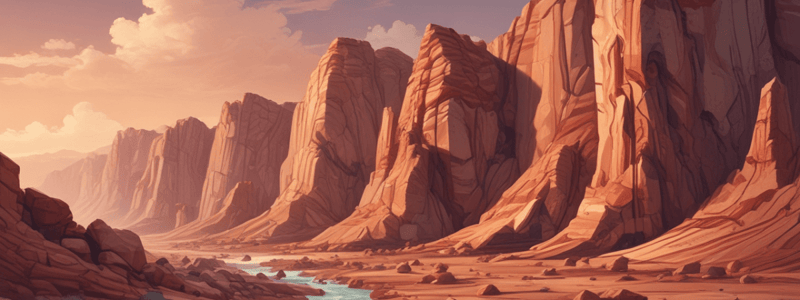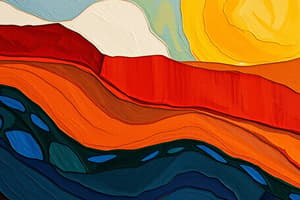Podcast
Questions and Answers
What is required to determine the origin of sedimentary rocks?
What is required to determine the origin of sedimentary rocks?
- A degree in geology
- Advanced laboratory equipment
- A mining permit
- A little bit of sleuthing (correct)
What is the purpose of studying the way sedimentary strata are laid out?
What is the purpose of studying the way sedimentary strata are laid out?
- To determine the age of the rock
- To find valuable resources
- To uncover clues about the origin of the rock (correct)
- To identify the type of minerals present
What are sedimentary rocks comprised of?
What are sedimentary rocks comprised of?
- Only minerals
- Only water and ice
- Only pre-existing rocks
- Bits of pre-existing rocks or minerals and some organic material (correct)
What is the term used to describe the layering found in sedimentary rock?
What is the term used to describe the layering found in sedimentary rock?
What is the process by which sediment grains get moved around?
What is the process by which sediment grains get moved around?
What is the result of layers of sediment building up over time?
What is the result of layers of sediment building up over time?
Why do sedimentary rocks preserve a record of history?
Why do sedimentary rocks preserve a record of history?
What do changes in color from one layer to the next in a sedimentary rock indicate?
What do changes in color from one layer to the next in a sedimentary rock indicate?
What is indicated by the presence of rounded grains in a sedimentary rock?
What is indicated by the presence of rounded grains in a sedimentary rock?
What is the characteristic of graded bedding in sedimentary rocks?
What is the characteristic of graded bedding in sedimentary rocks?
What is the significance of cross-bedding in sedimentary rocks?
What is the significance of cross-bedding in sedimentary rocks?
What is the likely origin of a sedimentary rock with ripple marks?
What is the likely origin of a sedimentary rock with ripple marks?
What is indicated by the presence of mud cracks in a sedimentary rock?
What is indicated by the presence of mud cracks in a sedimentary rock?
What is the significance of the shape of sediment grains in sedimentary rocks?
What is the significance of the shape of sediment grains in sedimentary rocks?
What is the common characteristic of graded bedding and cross-bedding?
What is the common characteristic of graded bedding and cross-bedding?
Flashcards are hidden until you start studying
Study Notes
Clues to the Origin of Sedimentary Rocks
- Sedimentary rocks preserve a record of history because of the way they form, comprising bits of pre-existing rocks or minerals and sometimes organic material like plant and animal remains.
- These sediment grains are moved by natural forces (water, ice, and wind) and settle in a new location, forming layers of sediment (strata) that build up over time and get compressed and cemented together to form rock.
Stratification
- Stratification is the layering found in sedimentary rock, with different types of sediment deposited on top of each other.
- Changes in color between layers provide clues about the rock, indicating different minerals and origins from different rocks or locations.
Graded Bedding
- Graded bedding is a sediment deposit characterized by a detectable sorting of grain size from bottom to top.
- Large, coarse sediment grains are deposited at the base of the layer, while small, fine sediments are near the top.
- This arrangement indicates that a current of water loaded with sediment rushed into place, allowing larger and heavier particles to settle out first, followed by lighter particles as the flow lessened.
Cross-Bedding
- Cross-bedding is layering within a rock that does not run parallel to the original horizontal layers.
- This suggests that the sediment was deposited on a slope or an angle, indicating an environment like a beach, river, or sand dunes.
- Forces like wind and water cause the erosion and redepositing of sediment grains in piles, which eventually become unstable and cascade downslope at an angle.
Ripple Marks
- Ripple marks are small wavy ridges of sediment caused by the action of waves or wind.
- These wavy ridges remain after the sediment hardens into rock, preserving the ripples.
- Ripple marks indicate that the rock originated in a stream bed, lake, or on a beach, and can provide information about the direction of water or wind currents.
Mud Cracks
- Mud cracks are multi-sided structures produced in fine-grained, muddy sediments that dry and shrink.
- They form in environments that go through periods of wetting and drying, such as marshes, seasonal rivers, and lake shores.
- Mud cracks fill with other types of sediment, preserving the cracked appearance within the rock and revealing that the sediments were deposited in an environment that was once wet and then dried.
Studying That Suits You
Use AI to generate personalized quizzes and flashcards to suit your learning preferences.




